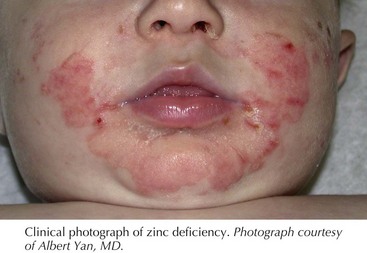127 Nutritional Dermatoses
Clinical Presentation
Zinc Deficiency
Zinc is an element that is a required component of many enzymes involved in the synthesis and degradation of lipids, protein, and nucleic acid. Classic skin findings of zinc deficiency include erythematous and slightly eroded plaques involving the extremities, diaper area, and periorificial area. The facial involvement often involves the lower cheeks and chin but spares the skin above the upper lip, giving a “U” appearance. The rash can present with exudate, crust, vesicles, and bullae (Figure 127-1). Chronic zinc deficiency often manifests with lichenified plaques. Candida spp. and Staphylococcus aureus superinfections are common in this disorder. Other cutaneous findings of zinc deficiency include stomatitis, angular chelitis, blepharitis, nail-fold inflammation with possible nail dystrophy, and hair thinning with areas of complete alopecia. In addition to dermatitis, diarrhea is a commonly associated symptom. The severity is highly variable and does not correlate with the development of cutaneous findings. Children with zinc deficiency also characteristically are irritable, have problems eating and sleeping, and are growth impaired.
Stay updated, free articles. Join our Telegram channel

Full access? Get Clinical Tree



